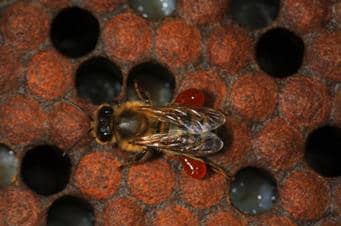
Fungal diseases of bees (mycoses) are among the infectious diseases, the causative agents of which are pathogenic fungi. The most dangerous are ascosphere, aspergillosis and melanosis. In dysfunctional apiaries, families develop poorly, the number of individuals in them sharply decreases, and the remaining in the nest reduces the ability to fly and honey.
Ascosferosis (calcareous brood) is a disease of bee and drone larvae, as well as pupae. Sometimes it affects the larvae in the queen cells.
Ascospheric pathogen – Asco-sphaera apis fungus – nests in diseased and dead larvae. By clearing the cells from them, the bees pollute their bodies with spores of the fungus and mechanically transfer the pathogen not only inside their nest, but also into other families. On neighboring apiaries, the disease usually appears after the attack and the wandering of the bees.
Healthy families are infected through brood, honeycomb, pests and parasites of bees. Very dangerous honey, pollen and pergam from disadvantaged families. Spores of the fungus can spread by beekeepers if the rules of hygiene are not respected, the use of non-disinfected inventory and hives.
The reason for the spread of ascospenosis can also be the uncontrolled use of antibiotics in the fight against infectious diseases of bees. This suppresses normal microflora in families and thereby creates favorable conditions for the life of pathogenic fungi.
Ascosphere is observed throughout the active beekeeping season. It quickly affects families with sudden fluctuations in air temperature, increased humidity, and a lack of protein feed. The larvae of three or four days are most susceptible. At the beginning of the disease, the larvae grow dim, stretch along the walls of the cells, do not react to touching them; at the bottom of the cells there is no royal jelly. Then the larvae thicken, become gray, the segmentation on their body is smoothed out; cells remain unprinted; on the larvae there are many individual white filaments of the mycelium of the fungus, which eventually cover their entire body. Only the dense ends of the larvae protrude, surrounded by yellowish rims. Often the larvae mummify.
At the last stage of the disease, the larvae calcify and turn into white and gray, like chalk, oblong lobes occupying two thirds of the cell volume. They often drop out of the cells; they are found at the bottom of the hive, a mesh stretcher and a board. The unappeared larvae clatter when shaking the frames. Some young bees from these families can see underdeveloped wings.
Families of bees can be simultaneously affected by ascospenosis and varroatosis. Therefore, we should not forget that antivaratogenic treatments affect the course of ascospenosis. The late use of aqueous solutions of acids causes a faster spread of it, as bees can not reduce the high humidity in the hive.
Медовые корпуса. Рулет с орехами и медом.
Diseases of bees